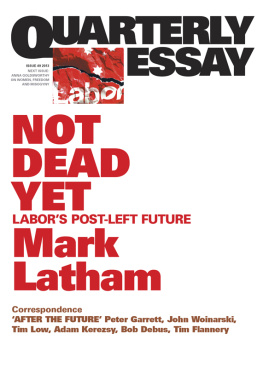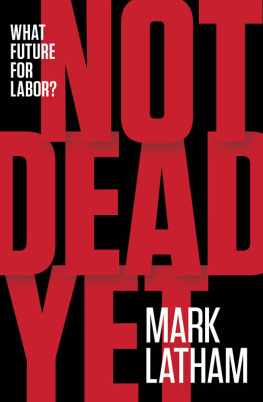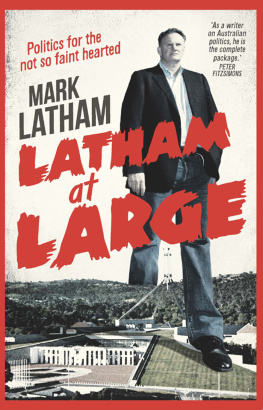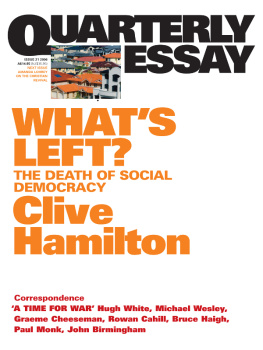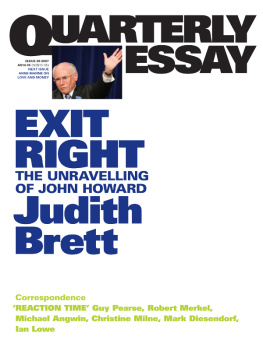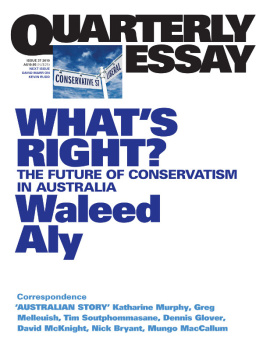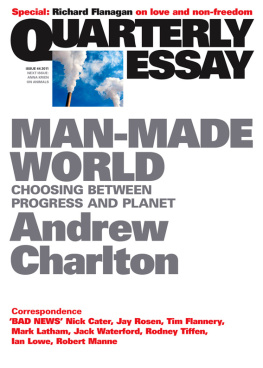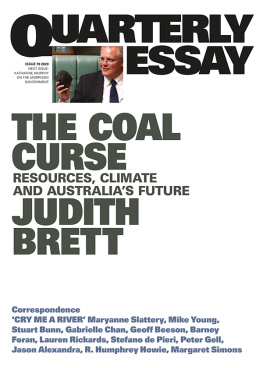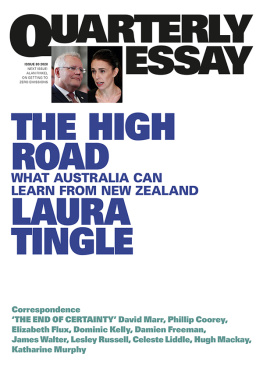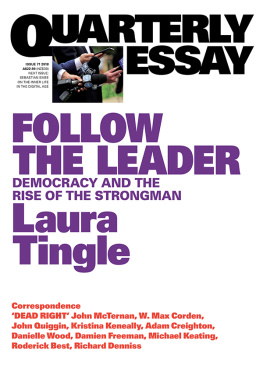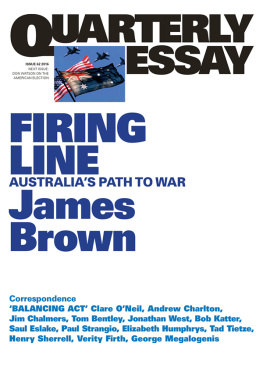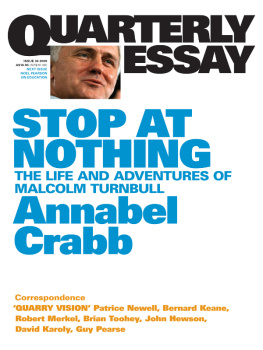NOT DEAD YET: Labors Post-Left Future
Mark Latham
In May last year something unusual happened. A Labor factional powerbroker said something positive about me. Speaking at the National Press Club in Canberra, the head of the NSW Right faction and secretary of the Australian Workers Union, Paul Howes, suggested it was time to end the mutual hostility between the party and myself.
Maybe the times come to stop being so particular about particular leaders or former leaders, constantly spending so much air-time ripping into ourselves, he said. Im as guilty of this as anyone else. The time has come for our movement to be more tolerant of dissent, to be more tolerant of diversity, to bring back those lost members, those cousins who dont come to Christmas anymore.
My last Christmas dinner with the ALP was in 2004. Four weeks later I resigned as the federal leader of the party and as the Member for Werriwa. My motivations were many: overcoming ill-health, ending the torment of time away from family, detesting large sections of the media and disenchantment with Labors union-based factional system. Thereafter, I allowed my ALP membership ticket to lapse, ending my 25-year involvement in party politics. I became a rare breed having resigned from parliament for family reasons I actually spent more time with my family, becoming the primary carer of my children.
In September 2005 I published my diaries, a frank account of life inside the Labor family. This ensured a long absence from future Christmas festivities. I was portrayed as a Grinch-like figure, the man who tried to steal Labors credibility. The initial reaction to my book was one of denial and denigration. With only a few dissenters, Australias political class united in declaring my critique to be absurd. To paraphrase the words of many: The Labor Party cant be as bad as that; the bastard has gone mad.
This remained the orthodoxy until the beginning of 2010. Then something changed. People who had once looked the other way in the shopping aisles at Woolworths began to greet me like a long-lost friend, exclaiming, Gee, you were right about Rudd in that book of yours. Labor Party members I had once known contacted me, expressing regret that they had not taken my views seriously and we had not stayed in touch.
Some media commentators even altered their stance, acknowledging that many of Labors problems, especially in its organisational roots, had been foreshadowed in The Latham Diaries . At this point, again in the spirit of Christmas dinner, I could have joined with Nol Coward in declaring, Legitimate at last. Wont Mother be pleased? My book had told the truth about Labors internal condition but, as often happens in public life, it took five years for the truth to be accepted.
Labors membership crisis
During the terms of the Rudd and Gillard governments, criticism of the ALP has become something of a national pastime. The processes of government have resulted in greater transparency about the true state of the Labor movement. The ALPs rank-and-file membership has collapsed, concentrating power in an oligarchy of union-based factional leaders. Active trade unionism has also declined, with the Health Services Union scandal revealing a culture of nepotism and financial abuse.
The two problems are linked. Union numbers at Labor conferences have conferred factional power on a relatively small number of union chiefs. This factional control, in turn, has spawned arrogance the type of conceit by which union officials assume that union money is their money. The countervailing influence of broad-based party and trade union membership, the traditional ballast of the Labor movement, has been lost.
Unionisation in Australia has fallen to 18 per cent economy-wide, with private sector coverage at just 13 per cent. Whether the traditionalists like it or not, minority union membership is here to stay. In a highly skilled and competitive modern economy dominated by small businesses, contractors and information workers it is impossible to organise mass union membership. A majority of economic agents see no need for collective representation. They have the qualifications and confidence to bargain effectively on their own behalf.
The problem for Labor, with its concentrated base of union affiliations and financing, lies in the organisational imbalance between the new economy and old-style unionism. In the workforce, unions have become a minority influence, whereas inside the ALP, through the strength of the factional system, they have maintained a majority complex, exercising control over party decision-making.
Having watched their relevance in the workplace fade over the past thirty years, union officials have compensated by beefing up their role inside the Labor Party. In practice in Australia, there is no longer any such thing as a powerful unionist, as expressed by the traditional notion of industrial leverage. There is, however, a generation of union leaders who have made themselves powerful by using their unions resources to exercise factional influence inside the ALP. This has been a classic big fish in a small pond strategy.
It has been made easier by the long-term decline in Labor branch membership. In any organisation, power flows to the centre whenever a critical mass of grassroots participation is lost. This concentration of influence usually results in self-serving processes and decisions, generating ethical problems and further disillusionment among rank-and-file members. In this fashion, oligarchies feature a vicious circle of centralised power and membership decline. Over time, the preservation of power internally is regarded as a higher priority than satisfying the organisations external goals.
The formalisation of Labors factional system in the 1980s has coincided with a hollowing out of party membership. The Labor historian Troy Bramston has chronicled the collapse: from 150,000 members nationally in the 1930s, to 50,000 in the 1990s, to just 11,665 members who voted in the ballot for the ALP national presidency in November 2011. In many parts of the nation, branches which once flourished as forums of working-class activism and community participation have closed down. At each election, the party has had to rely on a dwindling number of volunteers to distribute its literature and staff its polling booths.
The problem is particularly acute in outer-suburban areas the key marginal seats Labor needs to win to hold government. As the strength of union-based factionalism has increased, party members have lost interest in local branch meetings. Young families and professional people, already burdened by long commuting journeys and lifestyle pressures, have had no reason to maintain their involvement.
Compared to rival community organisations, the return on ALP membership is minimal. Active branch life has been reduced to a hard core of the ageing party faithful, plus members of parliament and their staff and other hustling aspirants for elected office. On the rollcall of inactive members, ethnic branch-stacking, while not as bad as in the 1990s, remains a problem.
In effect, Labor has split into two organisations, each operating in a different sphere of political activity. Branches go through the motions of monthly meetings and debate, knowing that their resolutions will be ignored by the party hierarchy. Their members blame the factional system for ruining the traditional Labor ethos of rank-and-file participation. This is the politics of permanent complaint at a local level.

